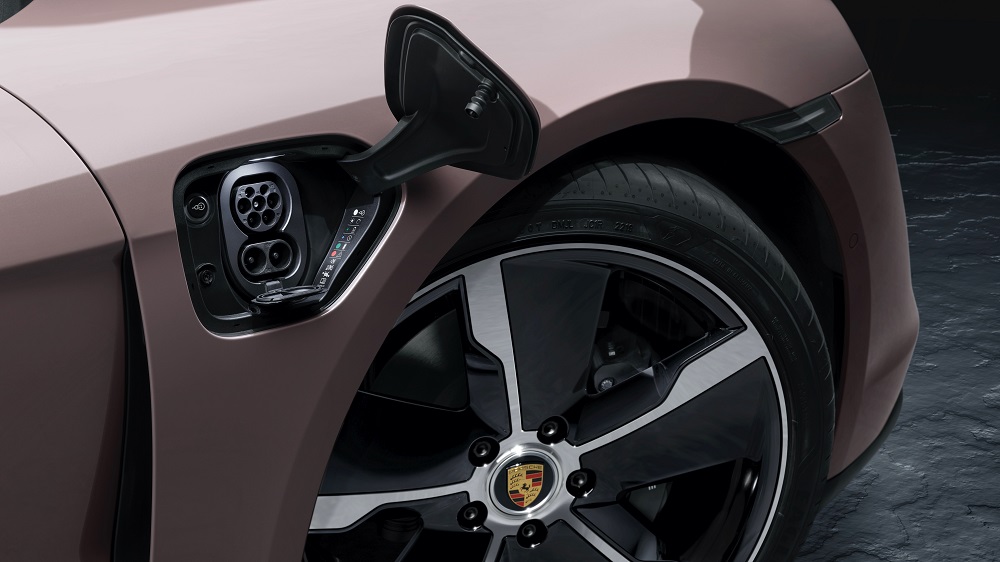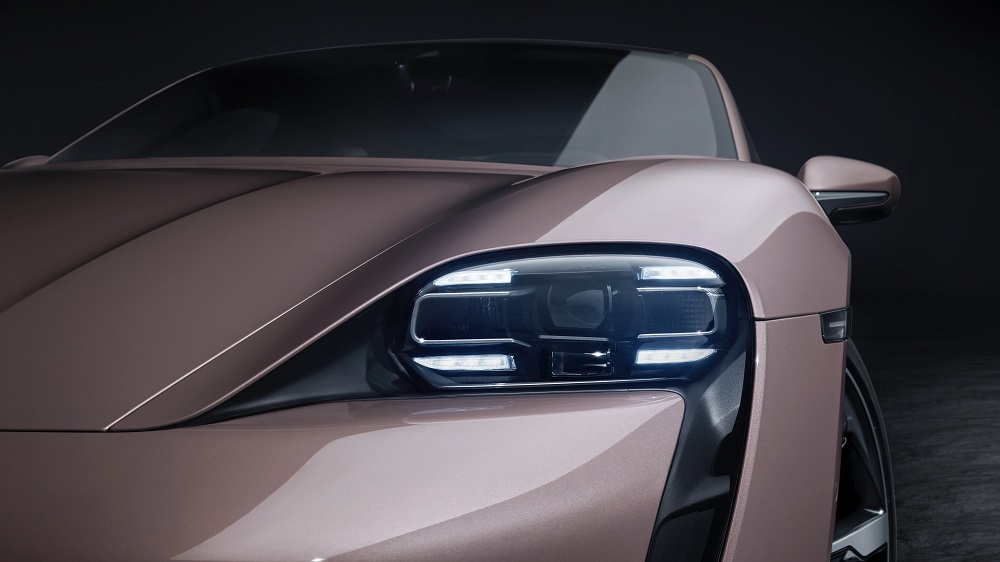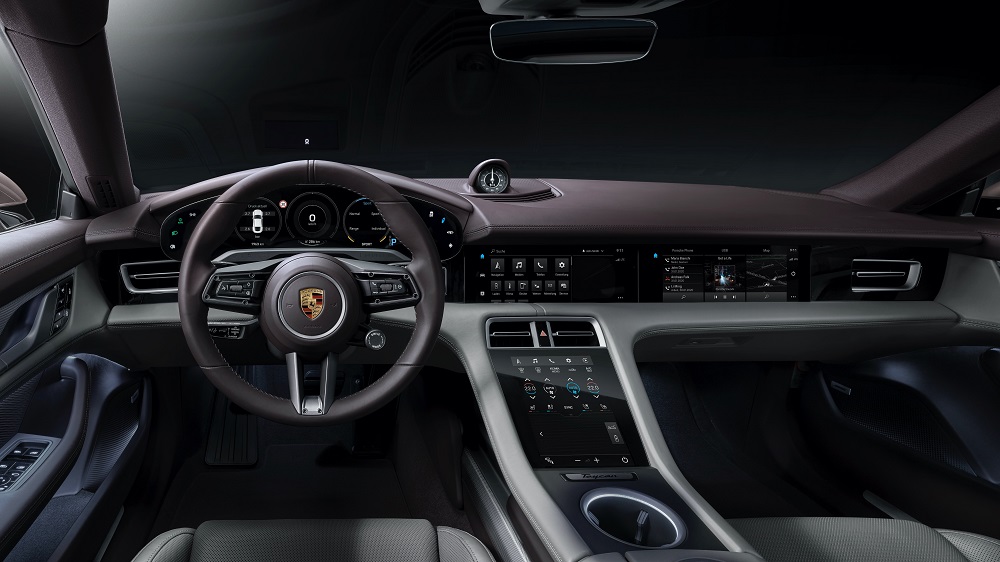With the new Taycan, Porsche is launching the fourth variant of its first all-electric sports saloon. The new model lines up alongside the Taycan Turbo S, Taycan Turbo and Taycan 4S. It features rear-wheel drive and is available with two sizes of battery.
With the standard Performance Battery, the new entry-level model delivers up to 408 PS in overboost mode with Launch Control; this increases to an output of up to 476 PS with the optional Performance Battery Plus. Nominal power is 326 PS or 380 PS respectively.
As the youngest member of the model family, the Taycan includes, right from the start, the new features introduced in the other versions at the model year changeover. For instance, the Plug & Charge function enables convenient charging and payments without the need for cards or an app: as soon as the charging cable is plugged in, the Taycan establishes encrypted communication with the Plug & Charge-compatible charging station. The charging process then starts automatically. Payments are also processed automatically.
As the youngest member of the model family, the Taycan includes, right from the start, the new features introduced in the other versions at the model year changeover. For instance, the Plug & Charge function enables convenient charging and payments without the need for cards or an app: as soon as the charging cable is plugged in, the Taycan establishes encrypted communication with the Plug & Charge-compatible charging station. The charging process then starts automatically. Payments are also processed automatically.
As on the other variants, optional equipment includes a colour head-up display and an on-board charger with a charging capacity of up to 22 kW. With Functions on Demand (FoD), Taycan drivers can purchase various additional convenience or assistance functions as required. Alternatively, they are able to book them for a limited period. This works after the vehicle has been delivered as well as for the sports car’s original configuration. Activation online means that it is not necessary to visit the workshop. Currently, this is possible for the Porsche Intelligent Range Manager (PIRM), Power Steering Plus, Active Lane Keeping Assist and Porsche InnoDrive functions.
A single-deck Performance Battery with a gross capacity of 79.2 kWh is fitted as standard. The two-deck Performance Battery Plus is available as an option. Its gross capacity is 93.4 kWh. Range, in accordance with WLTP, is up to 431 or up to 484 km respectively.
A single-deck Performance Battery with a gross capacity of 79.2 kWh is fitted as standard. The two-deck Performance Battery Plus is available as an option. Its gross capacity is 93.4 kWh. Range, in accordance with WLTP, is up to 431 or up to 484 km respectively.
The Taycan accelerates from a standing start to 100 km/h in 5.4 seconds, whichever battery is specified. Its top speed is also 230 km/h in both configurations, while its maximum charging capacity is up to 225 kW (Performance Battery) or up to 270 kW (Performance Battery Plus). This means that both batteries can be charged from 5 to 80 percent SoC in 22.5 minutes and that power for a further 100 km is achieved after only 5 minutes.
Impressive acceleration, tractive power typical of sports cars and outstanding continuously available power - the new point of entry to the Taycan model line-up also features these strengths. The permanently excited synchronous motor on the rear axle has an active length of 130 millimetres and is therefore the same length as the one fitted to the Taycan 4S. The pulse-controlled inverter on the rear axle operates at up to 600 amps.
Impressive acceleration, tractive power typical of sports cars and outstanding continuously available power - the new point of entry to the Taycan model line-up also features these strengths. The permanently excited synchronous motor on the rear axle has an active length of 130 millimetres and is therefore the same length as the one fitted to the Taycan 4S. The pulse-controlled inverter on the rear axle operates at up to 600 amps.
In addition to the permanently excited synchronous motor on the rear axle, the drive architecture also includes a two-speed transmission. Just as with its siblings in the model range, its highlights include intelligent charging management as well as exemplary aerodynamics. With a Cd value from 0.22, its aerodynamics make a significant contribution to its low energy consumption and therefore its long range. Maximum recuperation power is 265 kW.
With its purist design, the Taycan signals the beginning of a new era. At the same time, it retains the unmistakable Porsche design DNA. From the front, the electric sports car looks particularly low and wide, with highly contoured wings. Its silhouette is shaped by its sporty roof line sloping downward to the rear, while its highly sculpted side sections are also characteristic. The sleek cabin, the strikingly drawn-in C-pillars, and the pronounced shoulders of its wings result in a sharply emphasised rear, typical of the brand. These features are complemented by innovative elements such as the glass-look lettering for the Porsche logo in the rear light bar.
With its purist design, the Taycan signals the beginning of a new era. At the same time, it retains the unmistakable Porsche design DNA. From the front, the electric sports car looks particularly low and wide, with highly contoured wings. Its silhouette is shaped by its sporty roof line sloping downward to the rear, while its highly sculpted side sections are also characteristic. The sleek cabin, the strikingly drawn-in C-pillars, and the pronounced shoulders of its wings result in a sharply emphasised rear, typical of the brand. These features are complemented by innovative elements such as the glass-look lettering for the Porsche logo in the rear light bar.
Distinguishing features of the Taycan within its model family include aerodynamically optimised 19-inch Taycan Aero wheels and black anodised brake callipers. The front apron, side sills and rear diffuser in black are the same as those on the Taycan 4S. LED headlights are fitted as standard.
The cockpit of the Taycan signalled the start of a new era in 2019 with its clear structure and completely new architecture. The free-standing curved instrument cluster forms the highest point on the dashboard. This places a clear focus on the driver axis. Other elements include a central 10.9-inch infotainment display and an optional display for the front passenger.
The cockpit of the Taycan signalled the start of a new era in 2019 with its clear structure and completely new architecture. The free-standing curved instrument cluster forms the highest point on the dashboard. This places a clear focus on the driver axis. Other elements include a central 10.9-inch infotainment display and an optional display for the front passenger.
As standard, the Taycan comes with a partial leather interior as well as front comfort seats with eight-way electrical adjustment. The car features two luggage compartments: 84-litre at the front, and up to 407-litre at the rear. The Taycan is also the first Porsche model available with an entirely leather-free interior. Interiors made from innovative recycled materials underscore the sustainable concept of the electric sports car.
Porsche uses a centrally networked control system for the Taycan chassis. The integrated Porsche 4D Chassis Control analyses and synchronises all chassis systems in real time. Both the standard steel-spring suspension of the Taycan and the optional adaptive air suspension with three-chamber technology are supplemented by the PASM (Porsche Active Suspension Management) electronic damper control system.
The adaptive air suspension is also equipped with a Smartlift function. This allows the Taycan to be programmed so that it raises its ride height automatically at certain recurring locations such as road humps or garage driveways. The Smartlift function can also actively influence the vehicle’s height on motorway journeys and can adjust the vehicle’s ride height for the best possible compromise between efficiency and driving comfort.
Porsche uses a centrally networked control system for the Taycan chassis. The integrated Porsche 4D Chassis Control analyses and synchronises all chassis systems in real time. Both the standard steel-spring suspension of the Taycan and the optional adaptive air suspension with three-chamber technology are supplemented by the PASM (Porsche Active Suspension Management) electronic damper control system.
The adaptive air suspension is also equipped with a Smartlift function. This allows the Taycan to be programmed so that it raises its ride height automatically at certain recurring locations such as road humps or garage driveways. The Smartlift function can also actively influence the vehicle’s height on motorway journeys and can adjust the vehicle’s ride height for the best possible compromise between efficiency and driving comfort.
The Taycan is equipped as standard with six-piston aluminium monobloc fixed-calliper brakes at the front and four-piston aluminium monobloc fixed-calliper brakes at the rear. The internally vented brake discs are 360 mm diameter at the front and 358 mm at the rear. The brake callipers have a black anodised finish. A further option is the high-performance Porsche Surface Coated Brake (PSCB). Its discs have a diameter of 410 mm and 365 mm front and rear.
The first rear-wheel drive Porsche Taycans will make their way to dealerships from the middle of March 2021.













